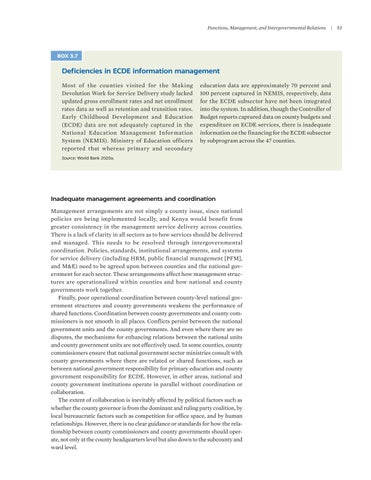Functions, Management, and Intergovernmental Relations
|
BOX 3.7
Deficiencies in ECDE information management Most of the counties visited for the Making Devolution Work for Service Delivery study lacked updated gross enrollment rates and net enrollment rates data as well as retention and transition rates. Early Childhood Development and Education (ECDE) data are not adequately captured in the National Education Management Information System (NEMIS). Ministry of Education officers reported that whereas primary and secondary
education data are approximately 70 percent and 100 percent captured in NEMIS, respectively, data for the ECDE subsector have not been integrated into the system. In addition, though the Controller of Budget reports captured data on county budgets and expenditure on ECDE services, there is inadequate information on the financing for the ECDE subsector by subprogram across the 47 counties.
Source: World Bank 2020a.
Inadequate management agreements and coordination Management arrangements are not simply a county issue, since national policies are being implemented locally, and Kenya would benefit from greater consistency in the management service delivery across counties. There is a lack of clarity in all sectors as to how services should be delivered and m anaged. This needs to be resolved through intergovernmental coordination. Policies, standards, institutional arrangements, and systems for service delivery (including HRM, public financial management [PFM], and M&E) need to be agreed upon between counties and the national government for each sector. These arrangements affect how management structures are operationalized within counties and how national and county governments work together. Finally, poor operational coordination between county-level national government structures and county governments weakens the performance of shared functions. Coordination between county governments and county commissioners is not smooth in all places. Conflicts persist between the national government units and the county governments. And even where there are no disputes, the mechanisms for enhancing relations between the national units and county government units are not effectively used. In some counties, county commissioners ensure that national government sector ministries consult with county governments where there are related or shared functions, such as between national government responsibility for primary education and county government responsibility for ECDE. However, in other areas, national and county government institutions operate in parallel without coordination or collaboration. The extent of collaboration is inevitably affected by political factors such as whether the county governor is from the dominant and ruling party coalition, by local bureaucratic factors such as competition for office space, and by human relationships. However, there is no clear guidance or standards for how the relationship between county commissioners and county governments should operate, not only at the county headquarters level but also down to the subcounty and ward level.
53


